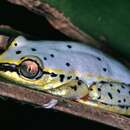Description
provided by AmphibiaWeb articles
Males can reach 35 mm and females 40 mm in snout vent length. However, all following data refer to smaller specimens; calls and natural history of large specimens are not known. The back is uniformly colored, often white when exposed to sunlight, sometimes yellow. A dark band is present between nostril and eye. The venter is whitish. Thighs, ventral surface of limbs, hands and feet are orange. Similar species: Heterixalus boettgeri differs by the more greenish dorsum; H. tricolor is similar in coloration, but the call is different. H. "variabilis" differs by call and coloration. H. punctatus has small black spots on the back and a different call.Taken with permission from Glaw and Vences (2007).
Nussbaum, R., Vences, M., and Glaw, F. (2008). Heterixalus madagascariensis. In: IUCN 2008. 2008 IUCN Red List of Threatened Species. www.iucnredlist.org. Downloaded on 01 April 2009.
- author
- Miguel Vences
- author
- Frank Glaw
Distribution and Habitat
provided by AmphibiaWeb articles
Ambila-Lemaitso, Andrakata, Antalaha, Fenoarivo, Fizoana, Ivoloina, Mahavelona, Manompana, Maroantsetra, Nosy Boraha, Sambava, Tampolo (Fenoarivo), Toamasina. It occurs between sea level and 800m asl along rainforest edges and in dry forested areas, littoral forest on sand, deforested areas, croplands and villages and urban areas (Nussbaum et al. 2008).
- author
- Miguel Vences
- author
- Frank Glaw
Life History, Abundance, Activity, and Special Behaviors
provided by AmphibiaWeb articles
The frogs are very common in dunes, savanna-like areas and deforested habitats of the east coast. Breeding seems to occur in temporary and permanent still water throughout the year (Nussbaum, R., Vences, M., and Glaw, F. 2008). Calling males were heard during February, March, July, August and October. In the evening, they sit in the vegetation above, or at the edge of, shallow ponds and swamps. During the day, they hide near pools, disappearing under water when disturbed. Females rest on leaves, and in leaf axils, of Typhonodorum, Pandanus, and other plants. The call consists mainly of two unharmonious note types. Type 1 lasts up to 2000 ms. The second type is shorter (about 50 ms) and arranged in series of many notes, with an interval between notes of 50 ms and a note repetition rate of about 9/s. These series are often preceded by a note of type 1. The frequency ranges from 2 to 5.5 kHz. Calls from Toamasina ranged from 3 to 4 kHz (note type 1) and from 2 to 4 kHz (note type 2). The recording is relatively bad, but the note repetition rate can be estimated as 10-11/s.Eggs, tadpoles in all stages, and metamorphosing juveniles were found in July. Total lengths range from 11-12 mm (stage 25) to 33-45 mm (stage 38-40). The caudal musculature, at mid length of the tail, represents about 1/4 of the total tail height. Tooth formula is 1//1+1/2 or 1//3. Metamorphosing juveniles have body lengths between 12 and 15 mm. Up to a size of 18 mm, dorsilateral bands are present in juveniles.
- author
- Miguel Vences
- author
- Frank Glaw
Life History, Abundance, Activity, and Special Behaviors
provided by AmphibiaWeb articles
It occurs in Parc National de Masoala, and perhaps in other protected areas (Nussbaum et al. 2008).
- author
- Miguel Vences
- author
- Frank Glaw
Heterixalus madagascariensis: Brief Summary
provided by wikipedia EN
Heterixalus madagascariensis (commonly referred to as the blue-back reed frog, or occasionally the powder-blue reed frog) is a species of frog in the family Hyperoliidae endemic to Madagascar. Its natural habitats are subtropical or tropical dry forests, subtropical or tropical moist lowland forests, moist savanna, subtropical or tropical seasonally wet or flooded lowland grassland, swamps, freshwater marshes, intermittent freshwater marshes, sandy shores, arable land, urban areas, heavily degraded former forests, ponds, irrigated land, and seasonally flooded agricultural land.
It is a popular choice of amphibian in the pet trade because of its beautiful colors and ease of care in a proper setup.
- license
- cc-by-sa-3.0
- copyright
- Wikipedia authors and editors

